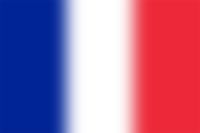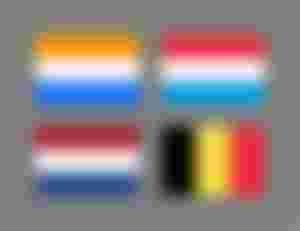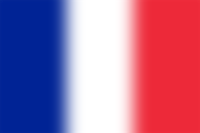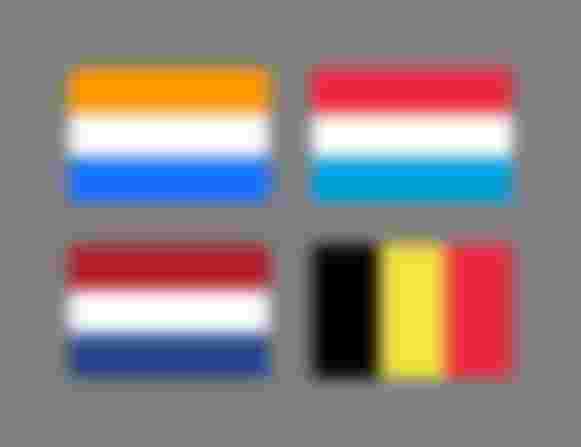A common pattern of a large number of flags in the world is three coloured vertical or horizontal bands. Strictly, three bands are a revolutionary symbol, a symbol of republic, although there are examples of monarchies using such a flag: namely the Netherlands, Luxembourg, and Belgium – that is the so-called Low Countries. There are historical reasons for these exceptions, as we shall see below. But let's start with the most famous tricolour, the French!
La tricolore, the Tricolour, generally means something with three colours, but more specifically it refers to the French (Republican and, under Napoleon I and Napoleon III, Imperial) flag, which was adopted in its present design in 1790, originally with the order of the coloured bands reversed. (1814/1815-1830, during the Bourbon royal restoration, France used a white flag, but la Tricolor was reintroduced in 1830, with the July Monarchy [Monarchie de Juillet].)

There are several explanations to the symbolic meaning of the three colours. The most common one might be that they stand for the three parts of the motto of the French Revolution: liberté, égalité, fraternité; blue, white, red. This, however, appears to me as being an after-thought post construction. All the three colours have deep roots in French history.
The red was the colour of the Oriflamme, the banner of Charlemagne (742-814, King of the Franks, King of Italy, and the first one with the title Holy Roman Emperor), which, according to legend, was given to him by the pope. It remained the battle standard of French kings during the Middle Ages. It is mentioned in Chanson de Roland. (The Song of Roland, the oldest work of literature in French.) The red colour of the Oriflamme was said to stem from the blood of St. Denis, in which it had been dipped after his beheading. (St. Denis, Bishop of Paris, who was beheaded and martured about 230 AD. Patron saint of Paris.)
While there are no historical records supporting the legend of the Oriflamme's origin with Charlemagne, its first appearance as a royal standard in verifiable history is as the battle standard of Louis VI in 1124. At that time it already was the established symbol of the Abbey of St. Denis, where St. Denis is buried, and was said to have been given to the abbey by the Merovingian king Dagobert.
In the battle of Agincourt, in 1415, the English captured the Oriflamme, and it has not been used since.
In reality, there was not one Oriflamme that was used all the time. This is obvious from the various descriptions that remain. It changed over time.
The earliest standard of the Frankish Monarchy was blue. It was the banner of the Church of St. Martin of Tours (St. Martin of Tours, 316-397, Bishop of Tours, strongly identified with the Merovingians), which became royal when Odo (Eudes), who was lay abbot of St. Martin, became King of the Franks in 888. Blue, later strewn with golden fleur-de-lis, remained a royal symbol after that. After the Hundred Years War, the blue bottom was increasingly replaced with white. This white was from the banner of Joan of Arc, and from her time white becomes important in French royal symbology.
There we have the colours: red, blue, white. Although the French Republic was a result of overthrowing an old monarchy, its symbolic colours all had their origin in royal history. Of course they were re-interpreted according to the new situation.
The Jacobin Club and later the Socialists used a red flag. That is the origin of the association of red with Communism and Socialism.
Blue and red, as in Paris' coat of arms (symbolising St. Martin and St. Denis), were the colours of Paris militia during the revolution. They used it on the cockades they had on their hats. White seems to have been added to “nationalise” the symbol. That was not uncontroversial, some people saw white as a symbol of monarchy; red-republic, white-monarchy. But finally, la Tricolor was adopted, as a symbol of French unity. No doubt, the choice of these three colours ultimately depends on their symbolic importance in French history.
The design of the French flag, three coloured bands, symbolises republic. It was used for the first time in that meaning from 1579, in the Prince's flag of William I of Orange-Nassau (see picture below), when he fought for the establishment of the Dutch Republic, separating it from Spain. The flags of Luxembourg and the Netherlands, although today these countries are not republics, are based on this one. Subsequently the use of flags with three coloured vertical or horizontal bands has spread around the world.
Here we can see The Prince's Flag (top left), Flag of Luxembourg (top right), Flag of The Netherlands (bottom left), and Flag of Belgium (bottom right).

The flags of Luxembourg and The Netherlands are directly based on The Prince's Flag. The design of the Flag of Belgium, is based on the French la tricolor, and the colours are taken from the arms of the Duchy of Brabant.
Related article: Fleur-de-lis & The Lily of Florence
Copyright © 2017, 2021 Meleonymica/Mictorrani. All Rights Reserved.
You find my articles related to symbols here, and to history here.
Interested in history, legends and myths, join my community History, Myths, Legends & Mysteries (be45).
You find all my writings on Read.Cash, sorted by topic, here.


Wow, such an interesting topic! Great job!